Easy Ways to Boost PC Speed
A sluggish PC can be a major roadblock, hindering your productivity and testing your patience. The culprits behind slow PC performance often lurk in the shadows of accumulated clutter, neglected maintenance, and outdated hardware. Unnecessary files, bloated startup programs, and malware can collectively weigh down your system, causing it to drag its virtual feet. Some common Reasons for slow PC performance are:
- Accumulated clutter and unnecessary files.
- Bloated startup programs.
- Malware and viruses.
- OutdateOutdated hardware and insufficient RAM.
The good news is that there are simple and effective ways to boost your PC’s speed without delving into complex technicalities. In this article, we’ll run through 10 easy and actionable methods to revitalize your computer’s performance, ensuring a smooth and responsive computing experience.
Clean Up Your Hard Drive
A cluttered hard drive is pretty much a messy workspace—it slows down your system’s ability to find and access the files it needs efficiently. By removing unnecessary files and programs, you free up valuable storage space and reduce the workload on your hard drive. This can be achieved using built-in tools like Disk Cleanup.
On a Windows PC:
- Use Disk Cleanup: This built-in tool scans your drives for temporary files and offers to delete them safely. Press the Windows key + R, type cleanmgr, and hit Enter. Select your drive and click OK. Choose the file types you want to remove and click Clean Up System Files.
- Delete Temporary Files Manually: Open File Explorer and navigate to C:\Windows\Temp. You can safely delete any files you don’t recognize or haven’t been modified recently. Be cautious not to delete anything you’re unsure about.
- Clear Browser Cache: Each browser stores temporary files to load webpages faster.
On Chrome: Click the three dots in the top right corner, select History > Clear Browsing Data, choose a timeframe, and tick the “Cached images and files” box before clicking Clear data.
On Firefox: Click the hamburger menu (three horizontal lines), select History > Clear Recent History, choose a timeframe, and tick the “Cache” box before clicking OK.
On Safari: Go to Safari > Preferences > Privacy, click Manage Website Data, and remove unwanted entries.
On a Mac PC:
- Use System Storage Management: Click the Apple logo in the top left corner, select About This Mac, then click Storage. Choose your startup disk and click Manage. Under the “Recommendations” section, click Reduce Clutter. You can then review and delete temporary files like “Downloads” and “System Junk”.
- Empty Trash Securely: Drag the Trash icon to the Dock for easy access. Right-click it and select Empty Trash Securely. This permanently deletes files, bypassing the Recycle Bin.
- Clear Browser Cache: Similar to Windows, each browser has its own method.
Safari: Go to Safari > Preferences > Privacy, click Manage Website Data, and remove unwanted entries.
Chrome: Click the three dots in the top right corner, select History > Clear Browsing Data, choose a timeframe, and tick the “Cached images and files” box before clicking Clear data.
Firefox: Click the hamburger menu (three horizontal lines), select History > Clear Recent History, choose a timeframe, and tick the “Cache” box before clicking OK.
Bonus Tip: Consider using third-party cleaning software like CCleaner or MacKeeper for a more automated approach. Remember to back up your data before using any cleaning tool, just in case.
Optimise PC Startup Programs
When you power on your PC, numerous programs launch simultaneously, consuming valuable resources. Optimising startup programs ensures that only essential applications load at boot, reducing the time it takes for your computer to become fully operational. This contributes to a quicker startup and an overall more responsive system.
- Open Task Manager: Press Ctrl + Shift + Esc together. This will open the Task Manager window.
- Switch to the Startup tab: Click on the “Startup” tab at the top of the window. You’ll see a list of all programs that are set to run at startup.
- Identify unnecessary programs: Look for programs you don’t need to run at startup, such as printing utilities, cloud storage apps, or media players. Programs with “High” or “Medium” impact on startup should be considered for disabling.
- Disable programs: Right-click on a program you want to disable and select “Disable”. This will prevent the program from launching automatically when you start your computer.
- Restart your computer: After you’ve disabled the programs you want, restart your computer to see the difference in boot time and performance.
On a Mac:
- Open System Preferences: Click on the Apple logo in the top left corner of your screen and select “System Preferences”.
- Go to Users & Groups: Click on the “Users & Groups” icon in System Preferences.
- Select your login item: Click on the “Login Items” tab. You’ll see a list of programs that are set to run at login.
- Uncheck unnecessary programs: Uncheck the box next to any program you don’t want to run at login. This will prevent it from launching automatically when you log in.
- Restart your Mac: After you’ve unchecked the programs you want, restart your Mac to see the difference in login time and performance.
A quick and responsive device could be the difference between a good day at the office or a frustrating one. It could also mean you meet that deadline in time or you achieve all you had on your to-do list for the day. Using the techniques clearly explained in this article, you can enhance both your efficiency and overall satisfaction with your device.
